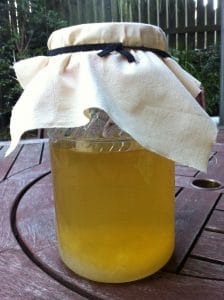
Water kefir is a traditional soda that is packed with probiotics. The probiotics in kefir are stronger than yoghurt. They are a symbiotic colony of yeast and bacteria working in harmony to aid digestion and take control of pathogens. Start slow on Kefir as you may have a die off reaction as the colony invades and takes over the pathogens. It’s worth pushing through die off as you’ll soon reap the benefits of a healthier gut. Kefir is easy to brew and kids love the bright fizzy drink. I always brew in two stages to keep grains pure and clean. As an added bonus I don’t have to pick fruit from the sieve or rinse the grains. The first ferment, the primary ferment is an aerobic ferment using the grains in straight sugar water. The grains are then sieved out, and started on another primary ferment. The kefir water is bottled and capped for a secondary anaerobic ferment with added fruit. The capping of the bottle creates the Fizz factor. You don’t have to cap if you prefer still.
 Equipment
Equipment
2 wide mouth glass jars
2 glass bottles with caps
Nylon mesh strainer
Funnel
Wooden spoon
Unbleached cloth**
Elastic band or string
Ingredients
4 tbsp water kefir crystals
2 heaped tbsp sugar*
½ tsp molasses
1 pinch of bi carb soda
approx 900ml of spring or reverse osmosis re-mineralised water
Method
1, Pour water into glass jar.
2, Add sugar, bi carb and molasses and stir.
3 ,Drain water crystals from previous ferment (or water they came in) into glass bottle. Use a wooden spoon, do not touch crystals with metal as it weakens them. Set bottled kefir water aside for secondary ferment.
4, Add grains to jar of new sugar water and stir gently.
5, Cover with cloth and fasten with an elastic band or string.
6, Cover with a second dark cloth or leave in a cupboard out of direct sunlight for 12-72 hrs depending on the weather.
12-72 hours later repeat steps 1 through 6.
You can drink the water kefir now, most people prefer to do a secondary ferment to add some fizz and flavours.
Refer here for water kefir FAQs.
Enjoy:)
*I use organic raw sugar.
** I use unbleached calico cloth or Christmas pudding cloth. These are cheaper and a finer weave than cheese cloth.
Here is my video covering Primary and Seconday Fermentation.



